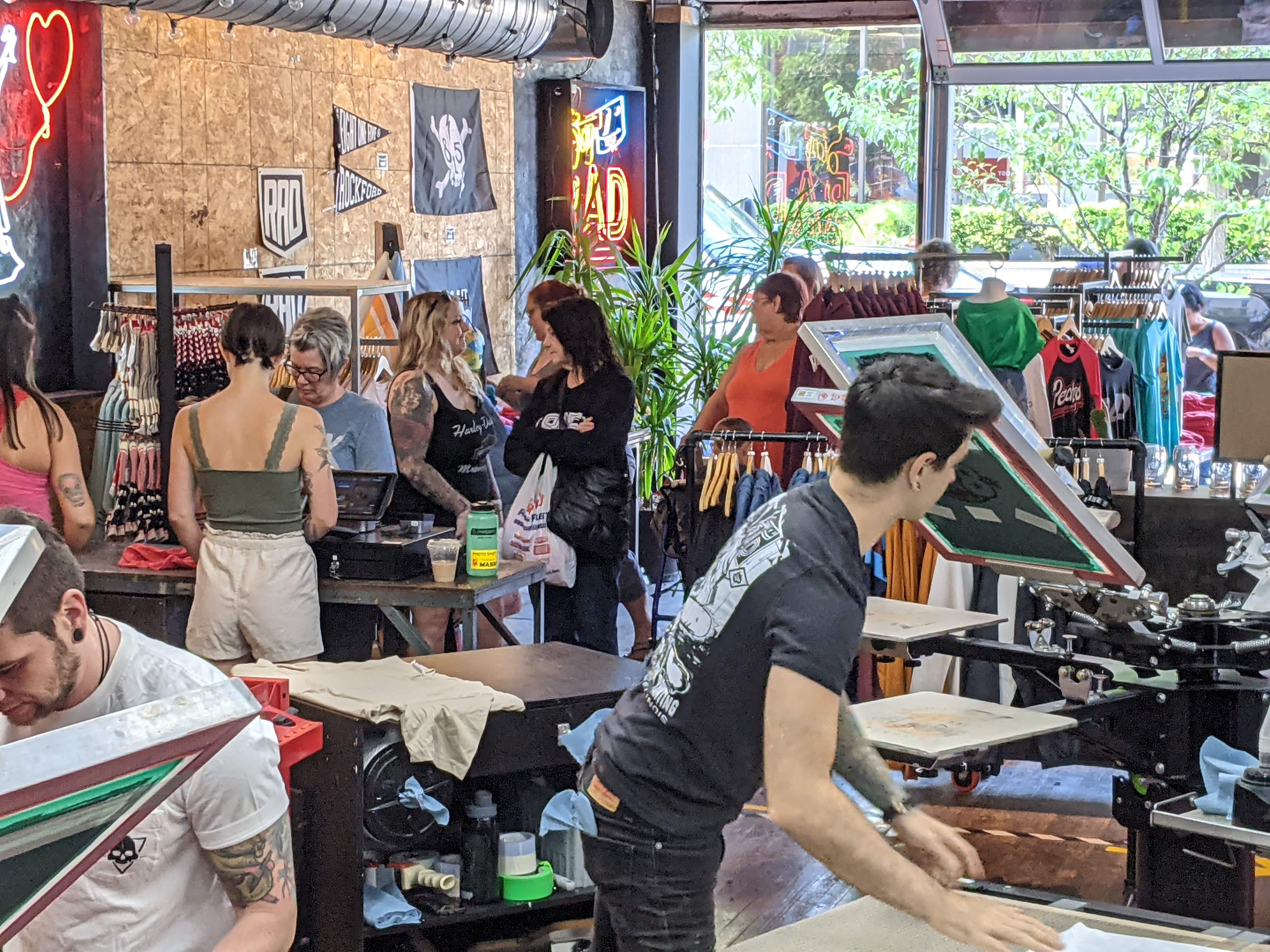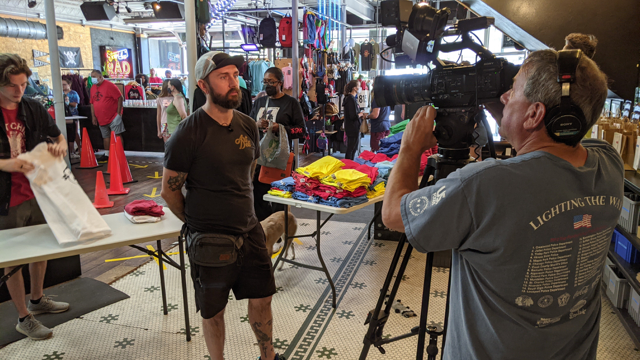It’s no secret: sales is hard.
There’s a long-standing idea that it takes a certain type of person to be great at sales. You can probably picture them: gritty, hard-nosed, totally comfortable with cold calling, practically relishes “no” but never lets someone walk away.
There’s some truth to this idea of the “natural sales disposition”—a few people have a natural aptitude for conversation and sales—but the overwhelming majority of great salespeople are made, not born.
They’re made through great techniques, systems, training, and a love for what they’re selling and who they’re selling to—and some luck, too.
After working with more than 3,000 print shops of all types at Printavo—from screen printers to embroiderers to no-touch brokers—we’ve seen some common and effective techniques that stand out.
Some are simple, some are more in-depth, but all are achievable.
1. Make a crowd: what will people wait in line for?
A crowd draws a crowd.
If you have a retail location—consider throwing an event. Whether it’s an open house, a “Free Print Day,” a contest, a concert or something else unique to your town—putting yourself at the center of activity is a surefire way to boost sales.
We’ve seen small screen printing shops do several months’ worth of sales by holding simple Free Print Days. Hundreds of people show up, spend their money and connect with the businesses that hold these events. Not a screen printing shop? Worry not—this model could work with any technique and be modified for all kinds of communities and events.
What can you get people to wait in line for?
Think hard about this question! Once you’ve drawn a crowd, funnel them toward your merchandise and make it easy to spend.
2. The real goal? Never sell at all.
The best sales technique? Never sell at all.
This sounds rosy, and it is, but the gist of the strategy is simple.
If you’re friends with people first, you never need to sell anything at all. Your product sells itself by virtue of who you are and what your business is known for.
“They’re the merch guys!”
People will naturally come to you and ask for help with their project because they know you can be trusted.
You accomplish this by situating yourself in the community you want to serve and building trust. This is an authentic move that can’t be faked and has no shortcut.
Love motorcycles and cars? Get in with the motorcycle and car community near you. Want to print athletic apparel? Start getting involved with local athletic events. Think you’d be brilliant at selling merch for bands? Figure out who’s who in your scene and make the connection. Start small but have faith that each action adds to the last.
This is the “X factor” that some businesses have and some don’t: they don’t need to “make sales” because whatever they do sells itself.
But make no mistake—cultivating a connection to a community you can surround your business with is the long-term key to making sales an afterthought.

3. Reduce friction: Quote fast and follow up
A big part of sales for any custom order is presenting a quote to the customer.
Lots of businesses struggle with quoting. It’s complicated, after all. Every order is a little different. Customers are in a hurry. It’s hard to capture exactly what they want.
The faster you can provide a quote, the faster customers can pay you and the faster you can get their merchandise out the door.
Customers will typically go to three vendors for quotes. Being the first to reply increases your chance of winning the deal. It doesn’t guarantee it, but effective follow-ups can leverage your speed.
Streamlining your quote process is one of the most effective sales strategies you can use. You’re removing the friction of a custom order.
How to accomplish this? We’ve seen shops implement these strategies:
• Limit what you offer significantly. Instead of offering entire catalogs, pick a few standout items that you sell. Stick to them. Quoting for 24 different high-quality items is much easier and faster than quoting for thousands of SKUs.
• Remove price breaks. Instead of playing the “what’s the price at 72 pieces,” use breakless pricing. This means pricing for profit at every quantity, instead of using quantity-based discounts.
• Say no. Have set parameters for how the quote process should go. If customers are overly price sensitive or demanding, say no! Quoting is not a revenue-generating activity by itself.
• Carefully document each phase of the quote process. Every sales team member should follow a checklist-like process for quoting, so that a customer could experience the same process regardless of whoever serves them.
• Follow-up, follow-up, follow-up. The follow-through email is so underutilized (and effective) that it feels like a dark art. Automate, at the least, a follow-up email for every quote. Text messages are even more effective.
4. Always engage
Sales is about making a human connection, first and foremost.
When a quote inquiry comes through, get on the phone right away to really engage the customer. You have to leverage the moment of interest right then and there.
You don’t need to cold-call every business in town. But the businesses that come to you and need help? Get in an offensive posture and call them. Let them know you’re there, ready, and able to offer value and a solution.
What if a client doesn’t love to talk on the phone? Utilize whatever medium they do prefer—whether it’s text, email or even DMs on social media.
Another tip we can’t oversell? Regularly check in on your biggest clients. Chew the fat. Build a relationship that goes beyond a transaction.
Keep regularly reminding them that you exist across different channels whenever possible. Even a brief comment on their latest Instagram post builds rapport and engagement.
5. Be the expert: Always have solutions
The mental model that most people have of sales—whether they’re the customer or the salesperson—is pretty rough. A pushy person demands your money and gets one over on you, utilizing mental dark arts to trick you into doing something you don’t want to do.
This is not a winning strategy. First—it’s really hard. And second—it just doesn’t work as well as being a solution recommendation engine.
If you want to sell more merchandise, solve more problems for your customers. That can be something simple like making sure items are bagged and tagged in a way that’s easy to distribute to more software-oriented workflows like making ordering and payment easier.
Functionally, this means sales staff need to have their ears to the ground about what works, what’s popular, and how to resolve common issues with a magical snap of the fingers.
If you want to add value—offer solutions to problems your customers have. Don’t become a problem (or annoyance) they have.

6. Scale up: Make a fast food menu
The idea of the “special meal” at a fast food chain is pretty incredible. What seems like a discount is actually a clever way to raise the average spend—and special meals can be far more profitable than individual items.
The same logic applies to selling custom merchandise. One of our favorite techniques is to create a fast food menu-like experience for different packages of your products. Special No. 1 is shirts, hoodies and hats. Special No. 2 is mugs, totes and pens. Maybe Special No. 3 is targeted toward restaurants and features signage, aprons and more.
Some shops even include pricing tiers in their specials, or limit the specials to a minimum order quantity.
The idea here is twofold:
1. Structure “specials” in a way that’s advantageous to your business. Price these packages at a compelling price point that’s still profitable.
2. Make ordering much simpler and easier to talk about. By limiting options, you make customers feel more confident in their decision making—which makes them faster to pull the trigger.
7. Hire help: Get an expert on your team
There’s no shortage of sales consultants, books, strategies, and advice. It’s easy to feel deluged by options—and every business owner already has enough choices to wade through each day.
One simple way to boost sales is to hire expert sales people. It seems like a no-brainer, but putting talented people in the right role is far more effective than continuing to devote time and energy to sales when it’s not your specialty.
Whether you poach a high-performing salesperson or use a recruiter to help you find good sales staff—adding an experienced salesperson is a winning move. Ideally, you’ll want to task them with building out your sales system versus simply making sales. That’s a long-lasting contribution!
We believe so strongly in this advice that we’ve started advising print shops of all sizes to invest heavily in their sales staffing. Sales are really the first step in your production process—and great sales (i.e. the right jobs at the right size at the right price) lead to far more efficiency.


